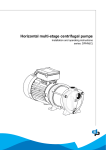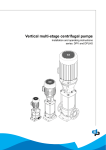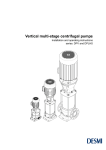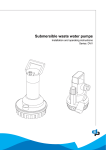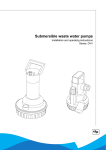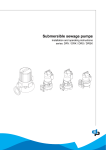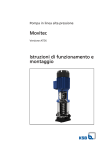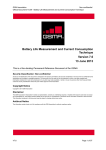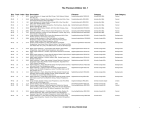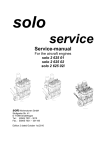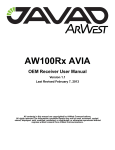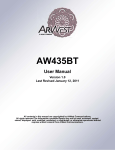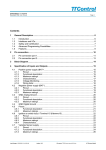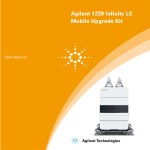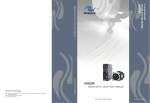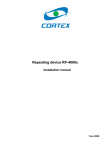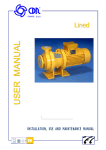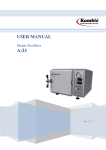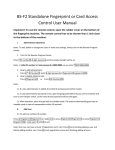Download Installation & operating instructions DPHM
Transcript
Horizontal multi-stage centrifugal pumps Installation and operating instructions series: DPHM(C) Table of Contents 1 Manual Introduction 1.1 1.2 2 Identification, service and technical support 2.1 2.2 2.3 2.4 3 9 Setting up the pump............................................................................................................................. 12 Electrical installation ............................................................................................................................ 13 Commissioning .................................................................................................................................... 13 Operation 8.1 2 Transport...............................................................................................................................................11 Storage..................................................................................................................................................11 Installation instructions 7.1 7.2 7.3 8 Model key............................................................................................................................................... 9 Description of the product ...................................................................................................................... 9 Intended use .......................................................................................................................................... 9 Operation ............................................................................................................................................... 9 Measuring, draining and venting.......................................................................................................... 10 Working range...................................................................................................................................... 10 Transport 6.1 6.2 7 General .................................................................................................................................................. 7 Users...................................................................................................................................................... 7 Safety provisions.................................................................................................................................... 7 Safety precautions ................................................................................................................................. 7 Environmental aspects........................................................................................................................... 8 Pump Introduction 5.1 5.2 5.3 5.4 5.5 5.6 6 Terms of warranty .................................................................................................................................. 6 Safety and environment 4.1 4.2 4.3 4.4 4.5 5 Obtaining data and information DPHM(C) 2/4/6 .................................................................................... 4 Seal codes ............................................................................................................................................. 5 Current ................................................................................................................................................... 5 Supplementary documentation .............................................................................................................. 5 Warranty 3.1 4 Preface................................................................................................................................................... 3 Icons and symbols ................................................................................................................................. 3 Operation ............................................................................................................................................. 15 Maintenance 9.1 9.2 Introduction .......................................................................................................................................... 16 Maintaining the pump for an extended period of non-operation .......................................................... 16 10 Failures 10.1 Failure table ......................................................................................................................................... 17 10.2 Torques of vent and draining plugs ...................................................................................................... 18 11 Annexes 11.1 EC declaration of conformity................................................................................................................ 19 1 Manual Introduction 1.1 Preface This manual contains important information for reliable, proper and efficient operation. Compliance with the operating instructions is of vital importance to ensure reliability and a long service life of the product and to avoid any risks. The first chapters contain information about this manual and safety in general. The following chapters provide information about normal use, installation, maintenance and repairs of the product. The annex contains the declaration(s) of conformity. • • • • 1.2 Make yourself familiar with the content. Accurately follow the directions and instructions. Never change the sequence of the operations to be carried out. Keep this manual or a copy of it together with the logbook in a fixed place near the product which can be accessed by all personnel. Icons and symbols In this manual and in all accompanying documentation the following icons and symbols are used. WARNING Danger of electric Voltage. Safety sign according to IEC 417 - 5036 WARNING Operations or procedures, if carried out without caution, may cause personal injury or damage to the product. General hazard sign according to ISO 7000-0434 ATTENTION Is used to introduce safety instructions whose non-observance may lead to damage to the product and its functions. ENVIRONMENTAL INSTRUCTION Remarks with respect to the environment. 3 2 Identification, service and technical support 2.1 Obtaining data and information DPHM(C) 2/4/6 H Figure 2: Duty point ID3297 4374 Ca/Ce/NBR/EPDM Figure 1: Pump with motor Table 1: Description nameplate Indication Meaning DPHMC 4/6 B Model key (design version B) 1.1 kW Installed motor power 50 Hz Nominal frequency ID 290048451060M Pump ID Q 4.3 m3/h Optimum capacity running at nfix (see fig. 2 Duty point) H 40.4 m PO 4 Optimum head running at nfix (see fig. 2 Duty point) Purchase order number Prod. 07/2014 1103153-4682 Production week/year and production serial number > as built file Seal. Ca/Ce/NBR/EPDM Mechanical Seal Surface Code and elastomer and pump elastomer, see table 2.2 Seal codes n fix. 2880 rpm Rotation speed indication at which Q/H are given T -10/+60°C Temperature range p PN10 Pressure Class connection 3060 The name plate indicates the type series / size, main operating data and identification number. Please quote this information in all queries, repeat orders and particularly when ordering spare parts. If you need any additional information or instructions exceeding the scope of this manual or in case of damage, please contact DP-Pumps nearest customer service centre. 2.2 Seal codes Table 2: Material code shaft seal Code acc. to EN 12756 Description Material B Spring loaded ring Carbon graphite Ca Resin impregnated Note V Seat ring Ceramic Ce Aluminium oxide E P Elastomers EPDM NBR EPDM NBR Ethylene propylene rubber Nitrile butadiene rubber F Spring CrNi steel F Other metal parts CrNi steel 2.3 Current 2.4 2.3.1 Nominal current The nominal allowable current of the motor is stated on the motor plate. This shows the nominal working range of the motor and can be used to protect the motor. Measuring the actual current of the pump during operation can be used to pre-set the motor protection switch to protect the pump/motor combination. This current value can also be used to determine the proper electrical equipment such as variable frequency drive, main switch, wiring diameter etc. Supplementary documentation Apart from this manual, the documentation given below is also available: Table 4: Supplementary documentation Document Code General terms of delivery 119 / 1998 DPHM(C) 2/4/6 Technical Data 50/60 Hz Version B 97004494 See also www.dp-pumps.com WARNING Not only the motor, but also the pump has to be protected in its application. Thermal circuit breaker 20 - 30 Thermal box Manual 2 Winding protection -20 - 50 Motor winding Automatic Reset Type of protection 1 Located in Protection device variant Suitable for ambient temperature [°C] 2.3.2 Motor protection Standard single phase motors are delivered including motor protection. The motor protection is provided either by a thermal circuit breaker or by a motor winding protection. Table 3: Type of protection Please contact your supplier for more detailed information about your motor protection. 5 3 Warranty 3.1 Terms of warranty The warranty period is settled by the terms of your contract or at least by the general terms and conditions of sales. ATTENTION Modifications or alterations of the product supplied are only permitted after consultation with the manufacturer. Original spare parts and accessories authorized by the manufacturer ensure safety. The use of other parts can invalidate any liability of the manufacturer for consequential damage. ATTENTION The warranty relating to the operating reliability and safety of the product supplied is only valid if the product is used in accordance with its designated use as described in the following sections of this manual. The limits stated in the data sheet must not be exceeded under any circumstances. The warranty becomes invalid if one or more of the points below occur. • The buyer makes modifications himself. • The buyer carries out repairs himself or has these carried out by a third party. • The product has been handled or maintained improperly. • The product has non original DP-Pumps spare parts fitted. DP-Pumps repairs defects under warranty when: • 6 They are caused by flaws in the design, the material or the production. • They are reported within the warranty period. Other terms of warranty have been included in the general terms of delivery, which are available upon request. 4 Safety and environment 4.1 General This DP-Pumps product has been developed using state-of-the-art technology; it is manufactured with utmost care and subject to continuous quality control. DP-Pumps does not accept any liability for damage and injury caused by not observing the directions and instructions in this manual, or in cases of carelessness during the installation procedure, use and maintenance of the product. Non-compliance with safety instructions can jeopardize the safety of personnel, the environment and the product itself. Non-compliance with these safety instructions will also lead to forfeiture of any and all rights to claims for damages. For example, in particular non-compliance can result in: • • • • • failure of important pump/system functions, failure of prescribed maintenance and servicing practices, injury to persons by electrical, mechanical and chemical effects, hazard of the environment due to leakage of hazardous substances, explosions. Depending on specific activities, extra safety measures may be required. Contact DP-Pumps if a potential danger arises during use. ATTENTION The owner of the product is responsible for compliance with the local safety regulations and internal company guidelines. ATTENTION Not only must the general safety instructions laid down in this chapter on "Safety" be complied with, but also the safety instructions outlined under specific headings. 4.2 Users All personnel involved in the operation, maintenance, inspection and installation of the product must be fully qualified to carry out the work involved and be aware of all applicable responsibilities, authorisations and super visions. If the personnel in question is not already in possession of the required know-how, appropriate training and instruction must be provided. If required, the operator may commission the manufacturer / supplier to take care of such training. In addition, the operator is responsible for ensuring that the contents of the operating instructions are fully understood by the responsible personnel. 4.3 Safety provisions The product has been designed with the greatest possible care. Original parts and accessories meet the safety regulations. Modifications in the construction or the use of non-original parts may lead to a safety risk. ATTENTION Make sure that the product operates within its working range. Only then the product performance is guaranteed. 4.3.1 Labels on the product The icons, warnings and instructions applied to the product are part of the safety provisions. The labels may not be removed or covered. Labels must remain legible during the entire life of the product. Replace damaged labels immediately. 4.4 Safety precautions 4.4.1 During normal use • Contact the local electricity company for questions about the power supply. • Protect the parts that can become hot, making direct contact impossible. • When applicable, always place undeformed coupling guards to protect the coupling, before putting the pump into use. Make sure that the coupling guards are never in contact with the rotating coupling. • Always close the terminal box of the motor. • Always close the control panel where applicable 7 4.4.2 During installation, maintenance and repair Only authorised personnel may install, maintain and inspect the product and repair electrical components. Observe the local safety regulations. WARNING Always disconnect the energy supply to the product first, before installation, maintenance and repairs. Secure this disconnection. WARNING Surfaces of a pump can be hot after continuous operation. WARNING Make sure that no one can be near rotating components when starting a pump. WARNING Handle a pump with dangerous liquids with the utmost care. Avoid danger for persons or the environment when repairing leakages, draining liquids and venting. It is strongly recommended to place a leakage tray under the pump. WARNING Immediately following completion of the work, all safety-relevant and protective devices must be re-installed and / or re-activated. WARNING Please observe all instructions set out in the chapter "Commissioning/Startup" before returning the product to service. 4.5 8 Environmental aspects 4.5.1 General The products of DP-Pumps are designed to function in an environmentally friendly way during their entire lifetime. Therefore, when applicable, always use biodegradable lubricants for maintenance. ENVIRONMENTAL INSTRUCTION Always act according to the laws, bylaws regulations and instructions with respect to health, safety and the environment. 4.5.2 Dismantling The owner is responsible for the dismantling and environmentally friendly disposal of the product. ENVIRONMENTAL INSTRUCTION Ask at the local government about the re-use or the environmentally friendly processing of discarded materials. 5 Pump Introduction 5.1 Model key Table 5: Model key Example DP H M C 2 /2 B Label DP Material/ Construction Product Label H Horizontal M All hydraulic parts Stainless Steel 1.4301 / AISI 304 with close coupled motor C Cast Iron pump casing Connections DIN connection size: suction G 5/4 - discharge G 1 Size (Capacity in m3/h at Qopt) 2 /2 Number of stages B Design version B 5.2 Description of the product The horizontal multi-stage centrifugal pump is designed for pumping clean, or slightly aggressive, watery mediums. The pump is easy to install, commission and operate. The hydraulic assembly is driven by an electric motor. All hydraulic parts of the pump are made of stainless steel. Pump casings are available in stainless steel or cast-iron. observe the instructions given in the user manual. When in doubt the product must be used as becomes evident from its construction, version and function. 5.4 Operation ID4376 D E C Intended use The pumps DPHM are suitable to transport and increase the pressure of cold and hot water without wear to parts within the indicated working range. The transport of liquids with a different viscosity or density than water is possible as well. For this a motor with an adjusted power could be required. Ask DP-Pumps or your distributor for advice. Any other or further use of the pump is not in conformity with its intended use. DP-Pumps does not accept any liability for any damage or injury that results from this. The pump is produced in accordance with the current standards and guidelines. Use the pump only in a perfect technical state, in conformance with the intended use described below. The Intended use as laid down in ISO 12100:2010 is the use for which the technical product is intended according to the specifications of the manufacturer. The use of the product has been described in the sales brochure and in the user manual. Always A F B Figure 3: DPHM(C) 2/4/6 20131394 5.3 The rotating impeller causes the pressure at the inlet of the impeller to drop. This decrease in pressure creates the flow through the suction connection (A). Every stage (B) consists of an impeller and a diffusor. The capacity of the pump is determined by the size of the passageway of the stage. The pressure of the stage is determined by the diameter of the impeller. Because of the modular type of construction it is possible to choose the number of impellers most suited to the required duty point. After leaving the last impeller the medium flows between the pump stages and the outer sleeve (C) and exits the pump at the discharge connection (D) 9 5.5 Measuring, draining and venting The pump is provided with plugs for measuring, draining and venting. Connection (E) is meant to fill and vent the pump, or to measure the inlet / suction pressure using a G ¼ connection. Connection (F) is meant to drain the pump, or to measure the discharge pressure using a G ¼ connection. 5.6 Working range DPHM note Ambient temperature [°C] -20 up to 30 (50) 123 Medium temperature [°C] -10 up to 60 Minimum inlet pressure Viscosity [cSt] Density [kg/m 3] Cooling NPSHreq. + 1 m Qmin/max [m3/h] size 2 pole , , 1-100 4 1000-2500 2 forced motor cooling Minimum frequency [Hz] 30 Maximum frequency [Hz] 60 5 Maximum number of starts see motor data sheet 6 Noise emission see motor data sheet 7 Allowable size of solids pumped For minimum/maximum flow at medium temperature of 20 oC see table 7 Minimum/maximum capacity (Qmin/max); for higher temperatures see figure 4 Minimum capacity vs. temperature (in % of Q optimum) Table 7: Minimum/maximum capacity (Qmin/max) Table 6: General working range specification Pump type ATTENTION The temperature difference between the medium and the pump should never exceed 60 °C. The pump must be filled / heated-up slowly in any case where the difference between pump and medium is more then 30 °C to avoid any chance of a thermal shock. 50 Hz 60 Hz Min. Max. Min. Max. 2 0.2 3.3 0.2 4.0 4 0.4 6.5 0.5 7.8 6 0.6 9.0 0.8 10.8 4431 5 µm to 1 mm 1. Avoid freezing the pump. 2. If the ambient temperature exceeds the above value or 11 Q% 10,5 10 the motor is located more than 1000 m above sea level, the motor cooling is less effective and could 9,5 require an adapted motor power. Please contact your Single phase motors are equipped either with a thermal circuit breaker or motor winding protection (see 2.3.2 Motor protection). Please contact your supplier for more detailed information about your motor protection. 4. Deviation in viscosity and/or density could require an adapted motor power. Please contact your supplier for more detailed advice. 5. Pumps that are intended for 50 Hz operation, may not 6. Frequent start/stops, in particular in combination with be connected to 60 Hz power supply. 10 higher pressure differences (Δp) may result in a shortened product lifetime. Consult your supplier for such applications. 7. Only the noise emission of the motor is documented. 9 40 45 50 55 T[°C] 60 Figure 4: Minimum capacity vs. temperature (in % of Q optimum) 4431 supplier for more detailed advice. 3. 6 Transport 6.1 Transport Always observe the directions as indicated on the installation by means of stickers. 1. 2. 3. Transport the installation in the position as indicated on the pallet or packaging. Make sure that the installation is stable. Observe the instructions on the packaging (if present). 6.2 Storage Fill the pump with glycol in order to protect it against the risk of frost. Table 8: Storage Storage tambient [°C] -10/+40 Max. rel. humidity 80% at 20 °C not condensing 6.2.1 1. Inspection during storage Turn the shaft every three months and just before putting into operation. 11 7 Installation instructions 7.1 Setting up the pump 6. ATTENTION Avoid stress in the pump casing caused by misalignment in the piping system. Please see table below. ATTENTION Pumps which do not stand steady or stable on their own, should be mounted on a rigid and stable base. ATTENTION Locate the pump at the place with the lowest risk for noise nuisance. To the suction line should apply: 1. 100% airtight. 2. No camber. 3. Running from the lowest point in the tank straight to the pump. 4. Provided with a foot valve that shuts off well, making sure that the suction line is always filled with water. 5. If the diameter of the suction line is larger than the pump-suction connection, then install an eccentric adapter in order to prevent air pockets and swirling. 7.1.1 Indicators ID4377 Figure 6: Terminal box and fan hood sticker 20131395 A Figure 5: DPHM(C) not connected 1. 2. 3. 12 4. 5. 20131398 The arrow (A) on the fan hood indicates the rotating direction of the motor in case of a 3 phase motor. Place and install the pump on a level, stable surface in a dry and frost-proof room. Place the pump as close to the source/tank as possible. Make sure that sufficient air can reach the cooling fan of the motor. For this purpose the free space above the cooling fan should be at least 1/4 of the diameter of the fan hood air intake. It is advised to install a shut off valve on the supply and on the delivery connection of the pump. To avoid medium flowing back through the pump, when idle, make sure a non-return valve is installed. 7.1.2 Install bypass Install a bypass if the pump may operate against a closed valve for a long period. The required capacity of the bypass is at least 10% of the maximum volume flow. At high operating temperatures a higher volume flow is required. With temperatures above 60ºC the required capacity is more than 10%. ATTENTION Do not make use of quick-closing valves and/or shut-off valves to prevent pressure impulses in the pump and in the lines as a result of changes in the flow rate 7.2 Electrical installation WARNING In accordance with the local regulations only authorised personnel is allowed to make electrical connections to the motor. ATTENTION Connect the motor according to figure 7 Motor connections and always check the rotation direction. Electrical connections: • Make sure that the motor specifications correspond with the power supply to which the pump motor is connected. Consult "Electrical diagrams" for the correct connection diagram. • Connect the motor using a motor safety switch. Example may differ upon chosen motor Figure 7: Motor connections 7.3 Commissioning WARNING The pump must be switched off when it is not completely filled up. 20140034 ID2482 ATTENTION Check the direction of rotation according to fig. 6 Terminal box and fan hood sticker. In case of a 3-phase motor the rotation direction can be changed by exchanging two of the 3 phases. 13 7.3.1 • • • Prime the pump A C B D Figure 8: Example: installation of a pump under pressure operation • • • • • • • • • • 20131396-A • • Close the discharge shut-off valve (B); Close the suction shut-off valve (A); Unscrew the fill plug (C); Gradually open the suction shut-off valve (A) until the liquid flows from the fill plug (C); Close the fill plug (C); Open shut-off valve (B); Vent the pump on discharge side for example via a venting valve (D) on discharge side (see Figure 8 Example: installation of a pump under pressure operation); Close the venting option on discharge side; • Close the discharge shut-off valve (B); repeat these steps until all air is removed from the pump; Make sure that the suction shut-off valve is entirely open. C B D Figure 9: Example: installation of a pump in suction-operation 20131397-A 14 Open the discharge shut-off valve (B); Remove the fill plug (C); Put a funnel into the port (C) and completely fill the pump with the liquid to be pumped; • Vent the pump on discharge side for example via a venting valve (D) on discharge side (see Figure 9 Example: installation of a pump in suction-operation); • Make sure all air is removed from the pump; • Close the venting option on discharge side; Close the discharge shut-off valve (B); Close the fill plug (C). 7.3.2 Start the pump • Start the motor; • Gradually open the discharge shut-off valve (B); • Make sure the pump started correctly within 20 seconds, if not then: • Switch off the motor; • Re-prime the pump; • Start the motor again; • Switch the pump off and on for 2-3 times, after running continues for 30 seconds and make sure all air is removed from the pump. 8 Operation 8.1 Operation The pump is controlled externally and therefore does not need any operation guidance. 15 9 Maintenance 9.1 Introduction WARNING Observe the general safety precautions for installation, maintenance and repair. Regular maintenance is necessary for the correct operation of a pump. Please contact your supplier for maintenance of the pump. 9.2 Maintaining the pump for an extended period of nonoperation Turn the shaft every three months1. This protects the seals from seizure. Protect the pump if there is a risk of frost. Proceed as follows: 1. 2. 3. 4. Close all pump valves. Drain each pump and/or the system. Remove all plugs from the pump. Open the shut-off and fill/air vent plug, if present. 16 1. period may vary per application or medium. Please consult your sales representative for application details. 10 Failures 10.1 Failure table WARNING Observe the general safety precautions before installation, maintenance and repair. Problem The motor is not running. Possible cause No voltage on the power terminal. Thermal motor safety switch triggered. The motor is running, but the pump does not work. Pump is vibrating and/or noisy. Internal failure. There is no water in the pump. No supply of the medium. Broken motor bearing. Available NPSH too low. (cavitation) Pump does not work in its working range. Possible solution Check the power supply. Checkpoints • Circuit • Main switch • Fuses Check the motor safety • Earth leakage switch relay • Protective relay Disconnect the motor from Check the free space of the motor and pump, the the main. Let the motor ambient temperature and cool down. The thermal the medium temperature. motor safety will reset it self. Contact the supplier, if this problem occurs often. Contact the supplier. Fill and vent the pump Make sure there is sufficient supply. Check for blockages in the supply line. Contact the supplier. Improve suction condition. Select another pump or adjust the system to work within its working range. Pump supplies insufficient Outlet and/or inlet shut-off Open both shut-off valves. capacity and/or pressure. valve is closed. There is air in the pump. Vent the pump. The suction pressure is Increase the suction presinsufficient. sure. Pump rotates in the wrong Change over L1 and L2 of direction. the three phase supply. Foot valve blocked. Clean the foot valve. The suction line has not Vent the suction line. been vented. Air bubble in the suction Install the suction line with line. pump end higher than the other end. 17 Problem Possible cause Pump supplies insufficient Pump sucks air because capacity and/or pressure. of leakage in the suction line. Water flow too low. So air bubbles clog up in the pump. The diameter of the suction line is too small. Capacity of water meter in the supply line is too small. Leakage. Pump failure. 10.2 Torques of vent and draining plugs 18 Dimensions Torques [Nm] PEHD G 1/4 3 AISI G 1/4 15 Figure Material Table 9: Torques Locations E and F in fig. 3 DPHM(C) 2/4/6 Possible solution Repair the leakage. Make sure the flow increases or use a smaller pump. Increase the diameter of the suction line. Increase the capacity of the water meter. Contact the supplier. Checkpoints 11 Annexes 11.1 EC declaration of conformity DP-Pumps Kalkovenweg 13 2401 LJ Alphen aan den Rijn, The Netherlands Tel: (+31)(0)-172-48 83 88 Hereby declares as manufacturer entirely on his own responsibility, that the products: Horizontal multi-stage centrifugal pumps, series: DPHM(C) Serial number: 18/2012 1000000-0001 [...] 52/2016 9999999-9999 to which this declaration refers, is in accordance with the following standard: EN 809: 1998+A1:2009/AC:2010 according to the provisions of the harmonized standard for pumps and which implies the regulations of Machine directive 2006/42/EC, EMC directive 2004/108/EC, in the most recent form The pump is subject to this declaration of conformity as a stand alone product. Make sure the appliance or installation in which the pump is built in, has got a declaration of compliance with the directives listed above, for its complete assembly. Alphen aan den Rijn 01/03/2014 Authorized representative W. Ouwehand, technical director. 19 dp pumps dp pumps P.O. Box 28 2400 AA Alphen aan den Rijn The Netherlands t +31 172 48 83 88 f +31 172 46 89 30 [email protected] www.dp-pumps.com 06/2015 BE00000554-D / EN Can be changed without prior notice Original instructions




















